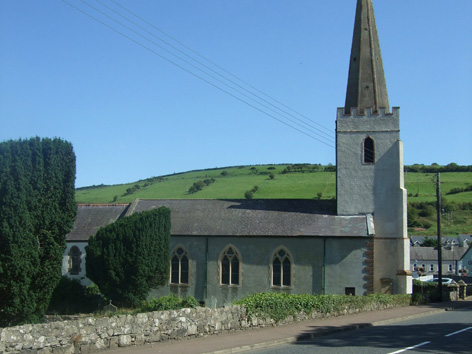
Welcome to St Patrick’s Church and Glenarm Friary
A place of antiquity
In 1465 a Franciscan friary of the Third Order Regular was established here, on a site that had been donated by Robert Bissett. Three centuries later the parish church was built here and remains in use to this day.
The medieval parishes of Glenarm and the Reformation
In the medieval period the Glenarm area was divided between two parishes – Templeoughter and Tickmacrevan. In the papal taxation of 1306 Templeoughter appears as the Church of St Mary of Glenarum, located within the demesne of Glenarm Castle, while Tickmacrevan is called the Church of St Patrick of Glenarum. Its parish church is recorded in a graveyard, at a place known as ‘the Glore’.
By the early seventeenth century both churches were in ruins. Neither appears to have been used as a place of worship after the Reformation. Instead, a new Protestant church serving both parishes was built in Glenarm. In 1657 this church was in repair and in 1679 it was described as bene se habet (literally ‘has itself well’).
Templeoughter gradually slipped out of use and Tickmacrevan came to be the collective name for both parishes.
The friary at Glenarm
In the early fifteenth century, Franciscan Third Order Regular communities began to be established in Ireland. In 1445 the archdeacon of Connor was sent a mandate by Pope Eugenius VI, authorising him to establish a Franciscan Third Order Regular friary in his diocese.
A 1580 map of the County Antrim coastline shows the friary at ‘Glanarme’ on the other side of the river from the castle. It was probably closed by the beginning of the seventeenth century, but its site continued to be the favoured burial place of the local population, including settlers from Scotland.
The new church in Glenarm
On 13 December 1759 an official order was issued in Dublin granting permission to build a new Church of Ireland church in Glenarm at the ‘vaults of the old abb[e]y being church ground and contiguous to the town of Glenarm.’ However, it was to be a few more years before building work began. In 1768 a parliamentary report of that year noted ‘a very good new church’ in Glenarm.
The new church is the earliest known example of Strawberry Hill ‘Gothick’ in an ecclesiastical building in Ireland. The church originally had a tower and spire, nave, and an unusual three sided chancel apse. In 1823 a gallery, south transept and vestry were added. In the 1870s the church was renovated under the direction of Lady Antrim and in 1871, she presented it with an organ. In 1878 the porch was added, the gallery removed and a Gothic arch was erected opening the tower into the nave. In 1892 the chancel was extended and a new vestry built.
The church features a fine collection of stained glass windows, including an intriguing single-light window in the south transept.
Description of friary remains
Little of the friary survives today, and what remains is not easy to interpret. It was aligned along the traditional east-west axis, so what was once thought to have been the chancel is now believed to have been a transept.
Archaeological investigations in the summer of 2005 revealed that the friary was larger than previously thought, with evidence of outbuildings uncovered beneath the vestry. Analysis of human remains, believed to date from the seventeenth century onwards, showed that most enjoyed a relatively good diet and were not subjected to hard physical labour. So it is likely that they were from the upper strata of local society.
The churchyard
The friary has been used as a place of burial for centuries, possibly back to its foundation. It was certainly in use in the seventeenth century for the earliest inscription dates from 1641, and there are at least two other memorials bearing dates prior to 1700. Though an act of parliament of 1698 banned burials within the confines of a dissolved monastery, this ruling was ignored by both Protestants and Catholics, and the site of the friary continued as the most important place of interment in Glenarm.

